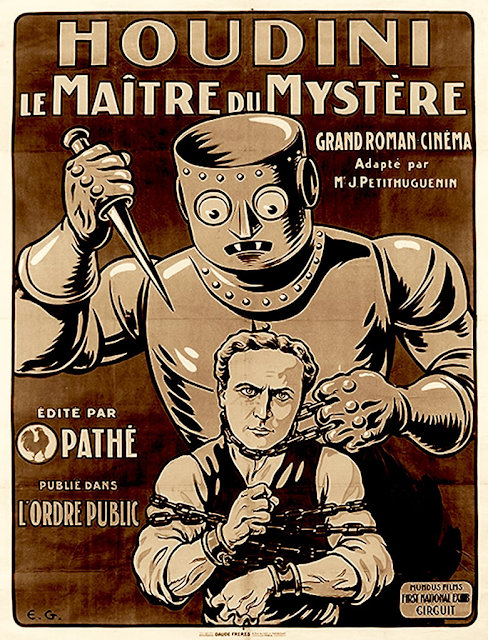Harry Houdini
Né Erik Weisz
Aka Eric or Erich Weiss, Harry Weiss
Performer, Magician, Illusionist, Escape Artist, Actor, Author, Aviator, Technical Advisor, Movie Producer & Director, Public Speaker, Psychic Investigator, Skeptic, & Debunker
Born March 24, 1874 (O.S.), Pest (Budapest), Kingdom of Hungary, Austro-Hungarian Empire
Died October 31, 1926, Detroit, Michigan
A lot has been written about Harry Houdini. I'm not sure that I can add to it. Instead I'll just write about him in his connections to genre fiction, genre films, and of course Weird Tales.
Born in Hungary to a rabbi and his wife, Houdini grew up in Appleton and Milwaukee, Wisconsin, then in New York City. He began performing--on a trapeze--at age nine and became a professional magician in 1891. He performed on the vaudeville stage, in circuses and museums, at the World's Columbian Exposition in Chicago in 1893, and--off and on from 1906 to 1923--in films. He was supposed to have played Captain Nemo in an adaptation of 20,000 Leagues Under the Sea, but that deal fell though. Instead, he appeared in a number of other genre films:
- The Master Mystery (1918), a fifteen-part thriller/mystery/science fiction serial on which Aleister Crowley (1875-1947) of all people served as a consultant.
- The Grim Game (1919), a crime thriller and aviation picture.
- Terror Island (1920), a South Seas adventure.
- The Man from Beyond (1922), a time-travel adventure with the ever-popular man-frozen-in-the-ice-then-thawed-out-and-reawakened plot device. There is also a depiction of reincarnation in The Man from Beyond, now interpreted as an attempt at reconciliation with Arthur Conan Doyle (1859-1930), whom had been alienated by Houdini's skepticism and debunking of spiritualism, mediums, and séances. (1)
- Haldane of the Secret Service (1923), a crime/detective story. Released on September 30, 1923, it was Houdini's last film. Weird Tales was halfway through its first year when Haldane arrived in theaters.
Although his name was known the world over, Houdini began slipping in his career by the time the 1920s rolled around. His last movies weren't very successful and so he put that business behind him. In February 1924, he announced that he was leaving the vaudeville stage and going on a twenty-four-date lecture tour to talk about "his experience with fraud medium." (2) He also announced that he had signed a contract to write a series of articles on the same subject for none other than Weird Tales magazine.
Maybe it was a step down for Houdini to get involved in pulp fiction, but that's what he did, meeting Weird Tales publisher J.C. Henneberger in his Chicago office in early 1924. (3) The two men swung a deal, and that's how the Houdini issues of Weird Tales came about. I won't go into the particulars here. You can read about the people, places, and events involved in John Locke's history, The Thing's Incredible! The Secret Origins of Weird Tales (2018), pages 136-156. Suffice it to say, Houdini had the cover story in three straight issues of the magazine, March, April, and the quarterly issue of May/June/July 1924. His likeness, by R.M. Mally, appeared on the first of the three, making Houdini the first author to be depicted on the cover of "The Unique Magazine."
To be continued . . .
Notes
(1) In his biography, Houdini: The Man Who Walked Through Walls (MacFadden, 1961), William Lindsay Gresham wrote: "The idea [behind The Man from Beyond] was probably suggested to Houdini by a story which appeared in The American Weekly about the body of a viking, complete with winged helmet and flaxen beard, which had been discovered in the Arctic, perfectly preserved after a thousand years." (p. 196) If we had the title of that story, we could add it to the Internet Polar Fiction Database and the Internet Viking Adventure Database. Was it one of A. Merritt's works? (My paperback edition of Gresham's Houdini lacks an index. Mention of Weird Tales and H.P. Lovecraft--"the late, great H.P. Lovecraft"--is on page 236.)
(2) "Houdini Leaving Stage," Minneapolis Star, February 23, 1924, page 8.
(3) John Locke suggests the week of February 11, 1924, as the period during which they met. See The Thing's Incredible!: The Secret Origins of Weird Tales (2018), page 138.
Original text copyright 2024 Terence E. Hanley


No comments:
Post a Comment